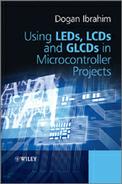Preface
A microcontroller is a single chip microprocessor system, which contains data and program memory, serial and parallel I/O, timers, and external and internal interrupts, all integrated into a single chip that can be purchased for as little as £2.00. About 40% of microcontroller applications are in office automation, such as PCs, laser printers, fax machines, intelligent telephones, and so on. About one-third of microcontrollers are found in consumer electronic goods. Products such as CD players, hi-fi equipment, video games, washing machines, cookers and so on fall into this category. The communications market, automotive market and the military share the rest of the application areas.
Input and output are very important parts of any microcontroller system. Typical input devices are push-button switches, keypads and various analog and digital sensors. Typical output devices are Light Emitting Diodes (LEDs), Liquid Crystal Displays (LCDs), Graphics Liquid Crystal Displays (GLCDs), motors, actuators, buzzers, and so on. This book is about the theory and applications of display devices in microcontroller based systems. The book explains briefly the theory of the commonly used display devices, namely LEDs, 7-Segment LED displays, LCDs, monochrome GLCDs and TFT based colour LCDs. In addition, the use of each display device is explained with several working and tested projects. The description, block diagram, circuit diagram, operation and full program code of all the projects are given. PIC18F series of high-end microcontrollers are used in all the projects. The projects are developed using the highly popular mikroC Pro for PIC compiler. Knowledge of the C programming language will be useful. Also, familiarity with at least one member of the PIC16F series of microcontrollers will be an advantage. The knowledge of assembly language programming is not required because all the projects in the book are based on using the C language.
This book is written for students, for practising engineers and for hobbyists interested in developing display based projects using the PIC series of microcontrollers.
Chapter 1 presents the basic features of microcontrollers and the basic features of display devices used in such systems.
Chapter 2 provides a review of the PIC18 series of microcontrollers. Various features of these microcontrollers are described in detail. The PIC18F2410 is chosen as a typical microcontroller.
Chapter 3 provides a short tutorial on the C language and then examines the features of the mikroC Pro for PIC compiler used in PIC series of microcontrollers.
Chapter 4 is about the important topic of microcontroller development tools. Both the software and hardware development tools are described in detail. In addition, the use of microcontroller simulators and in-circuit debuggers are described with examples.
Chapter 5 provides the basic theory of LEDs. The use of simple LEDs and 7-Segment simple and multiplexed LEDs are explained with examples.
Chapter 6 provides some simple projects using the PIC18 series of microcontrollers and the mikroC Pro for PIC C language compiler. All the projects in this chapter are based on the PIC18F452 microcontroller and all the projects have been tested and are working. This chapter should be useful for those who are new to PIC microcontrollers, and for those who want to extend their knowledge of programming PIC18F series of microcontrollers using the mikroC Pro for PIC language.
Chapter 7 covers the theory of LCD displays. The basic working principles of LCDs and the mikroC Pro for PIC built-in LCD functions are explained with several examples.
Chapter 8 is about the Program Development Language (PDL) used to describe the operation of software in general. Various building blocks of the PDL are described in this chapter.
Chapter 9 provides simple LED based projects, ranging from LED flashing to more complex LED projects.
Chapter 10 is about 7-Segment LED based projects. Several single digit and multiplexed working and tested projects are given in this chapter with full source code.
Chapter 11 provides several text based LCD projects. The use of LCDs is described in this chapter through simple and complex projects, ranging from displaying simple text on an LCD to developing an LCD based voltmeter project.
Chapter 12 is about the use of GLCDs in microcontroller projects. The use of standard monochromatic 128 × 64 pixel GLCD is used in the projects in this chapter.
Touch screen displays are important application areas of microcontrollers. Chapter 13 gives several projects on using touch screens in graphics applications.
The Visual GLCD software package is used for the development of projects based on several different types of monochromatic GLCD displays. Chapter 14 explains the use of this software package and gives the steps required to develop GLCD based applications. Several projects are given in this chapter using the Visual GLCD software package with both 128 × 64 pixel and 240 × 128 pixel GLCD displays.
Finally, Chapter 15 is about the Visual TFT software package used for the development of TFT based colour graphics applications. The chapter describes the steps required to create microcontroller based TFT graphics applications using the MikroMMB graphics development board.
Dogan Ibrahim
London, 2012
